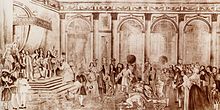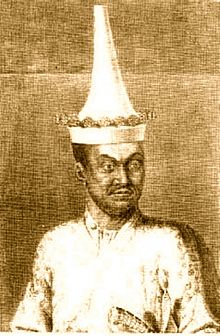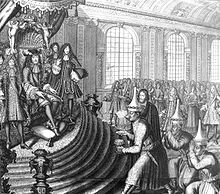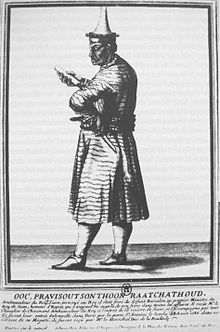- Kosa Pan
-
Pan (Thai: ปาน), known by his rank Chao Phraya Kosathibodi (Thai: เจ้าพระยาโกษาธิบดี, or Minister of Foreign Affairs and Trade) or former rank Ok Phra Wisut Sunthon (Thai: ออกพระวิสุทธิสุนทร, or First-Class Diplomat) or by the nickname Kosa Pan (Thai: โกษาปาน), was a Siamese diplomat and minister who led the Second Siamese Embassy to France sent by king Narai in 1686. He was preceded to France by the First Siamese Embassy to France, which had been composed of two Siamese ambassadors and Father Bénigne Vachet, who had left Siam for France on January 5, 1684.[1] His brother, Lek (Thai: เหล็ก), also ranked Chao Phraya Kosathibodi before him.[2]
Contents
Embassy to France (1686)
Main article: Siamese embassy to France (1686)Kosa Pan left for France in 1686, accompanying the return of the 1685 French embassy to Siam of Chevalier de Chaumont and François-Timoléon de Choisy on two French ships.[3] The embassy was bringing a proposal for an eternal alliance between France and Siam and stayed in France from June 1686 to March 1687. Kosa Pan was accompanied by two other Siamese ambassadors, Ok-luang Kanlaya Ratchamaitri and Ok-khun Sisawan Wacha,[4] and by the Jesuit Father Guy Tachard.
Kosa Pan's embassy was met with a rapturous reception and caused a sensation in the courts and society of Europe. The mission landed at the French port of Brest before continuing its journey to Versailles, constantly surrounded by crowds of curious onlookers.
1688 Siamese revolution
Main article: Siamese revolution (1688)Upon his return to Siam, Kosa Pan became one of the strongest supporters of Petratcha, the ruler who eliminated Narai and ousted the French, and became his Minister of Foreign Affairs and Trade.[5][6]
Kosa Pan is known to have been met in Siam in 1690 by the German naturalist Engelbert Kaempfer, who described "pictures of the Royal family of France and European maps" hanging "in the hall of his house":[7]
"He is a more comely Person, and of better aspect, than I ever met amongst this black race of mankind... He is also quick of understanding and lively action, for which reasons he was a few years ago sent Ambassador to France, of which Country, its Government, Fortresses and the like, he would often entertain us in his discourses; and the hall of his House, where we had a private audience of him, was hung with the pictures of the Royal Family of France, and European Maps, the rest of his furniture being nothing but Dust and Cobwebs.—Engelbert Kaempfer (1727/1987:38).[8]In 1699, Kosa Pan and Petracha received a visit by the Jesuit Father Guy Tachard, but the meeting remained purely formal and led to nothing.[9]
In 1700 Kosa Pan was disgraced, had his nose cut by king Petracha, and apparently committed suicide.[10]
See also
- France-Thailand relations
Notes
 Embassador Kosa Pan and Siamese envoys pay their respect to Louis XIV at his court in Versailles.
Embassador Kosa Pan and Siamese envoys pay their respect to Louis XIV at his court in Versailles.
References
- Gunn, Geoffrey C. (2003) First Globalization: The Eurasian Exchange, 1500-1800 Rowman & Littlefield ISBN 0742526623
- Smithies, Michael (1999), A Siamese embassy lost in Africa 1686, Silkworm Books, Bangkok, ISBN 9747100959
- Smithies, Michael (2002), Three military accounts of the 1688 "Revolution" in Siam, Itineria Asiatica, Orchid Press, Bangkok, ISBN 9745240052
- Suarez, Thomas (1999) Early Mapping of Southeast Asia Tuttle Publishing ISBN 9625934707
Categories:- Ambassadors of Thailand
- 17th-century people
- 1700 deaths
Wikimedia Foundation. 2010.



